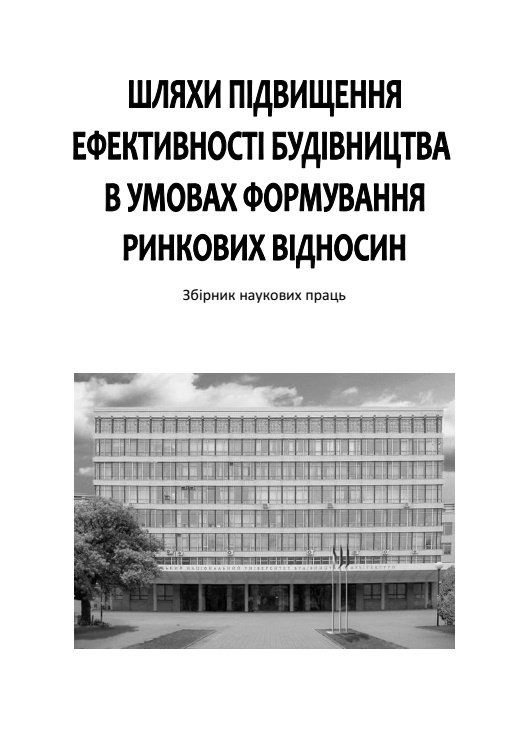The influence of the width of crack opening in reinforced concrete structures on the technology of their repair
DOI:
https://doi.org/10.32347/2707-501x.2019.39.154-161Keywords:
reinforced concrete structures, cracks, gluing, impregnation, injection, composite liquid.Abstract
The most frequent damages of concrete and reinforced concrete structures are cracks. According to DSTU B V.3.1-2: 2016, for their repair, solutions based on cement, Portland cement, thermosetting resins and thermoplastic polymers are used by injection and impregnation. The article presents the results of experimental studies to establish the influence of the width of crack opening of reinforced concrete structures on the technology of their injection with composite fluid. It was established that for cracks with the width of the opening up to 0.25 mm and for impregnating the body of the concrete to a depth of up to 2-3 mm, the effective composite liquid "Consolid 1" and the system "lotochok". For gluing cracks from 0.3 mm to 0.7 mm, the «Edmok Injection» composite liquid is effective. For gluing cracks with a opening width of 0.7 mm, the technology of impregnation of the structure with a composite liquid “Consolid 1” using the “lotochok” system and injection of cracks with the “Edmok injection” composite liquid 24 hours after impregnation is effective.
References
ДСТУ Б В.2.6-178:2011 «Конструкції будівельні стінові. Метод визначення міцності зчеплення облицювальних плиток з основою» Чинний з 01.10.2012 – Київ, 2012. – Міністерство регіонального розвитку, будівництва та житлово-комунального господарства України. – 29 с.
ДСТУ Б В.3.1-2:2016 «Ремонт і підсилення несучих і огороджувальних будівельних конструкцій та основ будівель та споруд», видання офіційне. Чинний з 01.04.2017– Київ, 2017. – ДП «УкрНДНЦ». – 72 с.
Звіт про науково-дослідну роботу «Проведение экспериментально-теоретических исследований влияния на несущую способность железобетонных элементов, усиленных металлическим листом и композитным материалом, приклеенных клеями заказчика». – ДП «НДІБК». – Київ, 2003. – 103 с.
Молодід О. С. «Експериментальні дослідження технології склеювання тріщин залізобетонних конструкцій просочуванням» / О. С. Молодід, Р. О. Плохута // Міжнар. наук.- техн. журнал «Сучасні технології, матеріали і конструкції в будівництві». – Київ, 2018. – том 25 № 2. – с. 45-50.
Пат. Україна, 114090 МПК Е04В 1/62 (2006.01) «Спосіб ремонту та захисту горизонтальних залізобетонних конструкцій з великою кількістю тріщин ін’єктуванням за допомогою «лоточка»» / О. С. Молодід, Р. О. Плохута, В. О. Колесніков/. – опубл. 27.02.2017. Бюл. № 4.
ТУ У 30553286,001-2000 «Пропитка композиційна «Консолід»». Технічні умови. – 2000. – 9 с.
ТУ У 30553286.003-2001 «Клей епоксидний «Едмок»». Технічні умови. – 2001. – 12 с.
EN 1542:1999 «Products and systems for the protection and repair of concrete structures. Test methods. Measurement of bond strength by pull-off» (Материалы и системы для защиты и ремонта бетонных конструкций. Методы испытаний. Измерение прочности сцепления при отрыве) – Was approved by CEN on 15 August 1999. – 10 pp.
Downloads
How to Cite
Issue
Section
License

This work is licensed under a Creative Commons Attribution 4.0 International License.
Authors who publish with this journal agree to the following terms:
- Authors retain copyright and grant the journal right of first publication with the work simultaneously licensed under a Creative Commons Attribution License that allows others to share the work with an acknowledgement of the work's authorship and initial publication in this journal.
- Authors are able to enter into separate, additional contractual arrangements for the non-exclusive distribution of the journal's published version of the work (e.g., post it to an institutional repository or publish it in a book), with an acknowledgement of its initial publication in this journal.
- Authors are permitted and encouraged to post their work online (e.g., in institutional repositories or on their website) prior to and during the submission process, as it can lead to productive exchanges, as well as earlier and greater citation of published work (See The Effect of Open Access).

